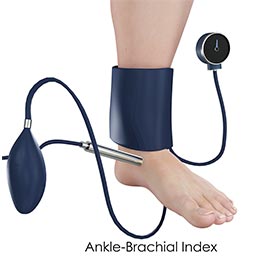Peripheral Arterial Disease (PAD)

Peripheral arterial disease, also known as peripheral vascular disease, is a common vascular condition in which blood supply to the limbs is reduced due to the narrowing of arteries.
Arterial Doppler Ultrasound

Arterial Doppler ultrasound is a non-invasive imaging test used to visualize the blood flow in the arteries, by bouncing high frequency sound waves(ultrasound) over the circulating blood cells.
Ankle Brachial Index

Ankle-brachial index test is performed at the doctor’s office and doesn’t require any specific preparation. You will have to lie on the table, your doctor will use a standard blood pressure cuff to measure the pressure in your arms and in two arteries near each ankle.
Peripheral Vascular Disease Screening

Peripheral Vascular Disease (PVD) also referred to as peripheral artery disease is a common disease that occurs when the blood vessels that supply blood to the limbs and other organs of our body are partially or completely blocked due to plaque build-up,
Peripheral Vascular Interventions

Peripheral arterial disease (PAD) is a serious condition that forms plaque due to buildup of cholesterol and scar tissue inside the arteries. Individuals with PAD tend to have blocked or narrowed arteries in the legs, neck, arms and abdomen.
Peripheral Artery Catheterization

Peripheral artery catheterization is a minimally invasive procedure in which a tiny flexible tube known as a catheter is inserted into a peripheral artery (leg or arm) that has narrowed or occluded in order to allow passage of oxygenated blood.
Angioplasty and Stents

Arteries, blood vessels that carry oxygen-rich blood to all the parts of the body, are normally flexible and smooth on the inner side, but deposits of cholesterol, calcium, and fibrous tissue (plaque) can build up on the inner walls of the arteries
Critical Limb Ischemia (CLI) program

Critical limb ischemia (CLI) refers to severe blockage of the arterial blood flow in both upper and lower limbs. It is an advanced stage of Peripheral Artery Disease (PAD). There is progressive worsening of the condition due to thickening of the arterial inner lining by a fatty substance which blocks the blood flow and is commonly known as atherosclerosis.



